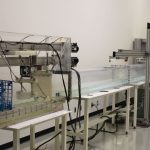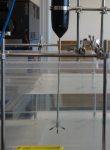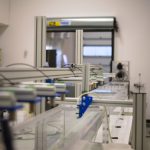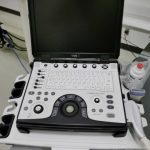This room is dedicated to coastal and river hydraulics, a research field shared with the INRS Environmental Hydraulics Laboratory (LHE), which possesses the largest wave flume in North America. The HYDEES room is complementary to the LHE, enabling high-resolution studies on sediment transport hydrodynamic processes. The room’s hydraulic flumes are small enough to fit inside the medical CT scanner and can be equipped to measure waves and/or water depth and water velocity (point, 1D profile, 2D or 3D vector fields) at a high frequency for turbulence or non-linear phenomena. These flumes enable the documentation of complex sediment–hydrodynamic processes and the development of computational fluid dynamic (CFD) codes that are also used by the LHE Lab.
Wave flume
| The small wave flume (9 m long, 0.3 x 0.3 m cross-section) is dedicated to coastal hydraulic experiments. The wave generator works in two modes: piston or swing shutter. It can reproduce to scale the same wave conditions as the LHE’s large wave flume (regular or irregular waves, solitary waves or tsunamis). |
 |
Current flume
|
The small current flume (7 m long, 0.3 x 0.3 m cross-section) is dedicated to fluvial hydraulic experiments. It is equipped with an adjustable flow rate pump (up to 45 l/s) producing upstream to downstream flow for steady-state studies. It is possible to study flow around obstacles (bridge piers, sea cobs, for example) or sedimentary erosion.
|
 |
Reclining, variable section current and wave flume
| This new platform is under assembly. It will allow sub- and supercritical, non-uniform and unsteady flow experiments. Fully modular, this flume can produce flow contractions and expansions over a section 0.3 x 0.3 m at one end and 0.15 x 0.3 m at the other. More details to come. |
 |
Particle image velocimetry (PIV)
| 2D and 3D velocity fields are obtained with PIV. Two PIV systems can be combined for 2S2C measurements (1 camera, 2 components), 2D3C measurements (2 cameras in stereo, 3 components) or tomo 3D (4 cameras, 3 components). One of the systems is dedicated to high-speed measurements, from a maximum of 1.4 kHz at high resolution (2560 x 1600 pixels) up to 290 kHz at very low resolution (128 x 4 pixels). |
 |
Acoustic velocimetry
| Acoustic velocity measurements using the Doppler effect can be made with three Nortek© instruments. Two sensors make point measurements of a small 3D volume, and the third one measures a velocity profile a few centimetres long. This technology is complementary to PIV, notably to measure velocities in high turbidity conditions. |
 |
Water level
| For water-level measurements, and wave height in particular, acoustic measurements using General Acoustics© sensors can be made at a resolution of 0.18 mm with a sampling rate of up to 100 Hz. For higher sampling rates, intrusive electrical sensors are available. |
 |
Echo-Doppler imagery
| A GE LOGIQ e R7 medical ultrasound echo sounder equipped with a linear L4-12-RS probe can be used for multibeam bathymetric sounding in shallow water. |
 |







